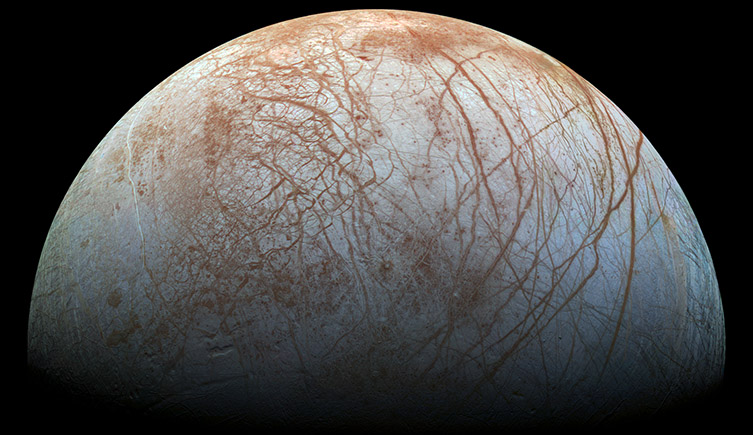Project overview
Possible chemical compositions of icy moon brine oceans include salt-water mixtures of Na-K-Mg-Ca-Cl-SO4-CO3-H2O [1]. While direct probing of the ocean is very difficult, surface observations are an indirect way to investigate the brine ocean due to transport processes between the two [2].
Spectroscopic measurements suggest the presence of a range of highly hydrated salts [3], however, no complete match to the observed data has been made. Part of this problem lies in the limited number of available library spectra, especially for salt hydrates that are formed at high pressure and low temperature, conditions found under the icy crust.
While most of the currently known salt hydrate phases are formed and studied at ambient conditions, low temperatures and high pressures are important thermodynamic variables to stabilise new forms of salt hydrates, especially with high hydration levels [4, 5].
For this project, we will extend the library of salt hydrates, especially to the extreme conditions known on icy moons, by performing in-situ experiments using cryo-cooled diamond-anvil cells. The stability and infrared spectra of the new salt hydrates will also be investigated upon cold decompression, which can reveal the likely phases present on the icy surfaces [4].
While initially pure solutions of salt hydrates are studied, further complexity will be added to approach natural brine oceans by including (i) nucleating agents, and (ii) binary salt mixtures to determine their impact on salt hydrate phases and stability ranges.
This work will not only provide key mineralogical information for icy moons that is relevant to the launched ESA Jupiter Icy Moons Explorer (JUICE) and NASA Europa Clipper space missions [6, 7], but will also allow us to make fundamental structure-chemical relationships.
The main goals of this project include:
1) Characterise novel salt hydrate phases at the conditions of icy moons. With the use of both high-pressure and cryogenic cooling techniques, the stability, properties, and mineralogy of the salt hydrates can be mapped according to the conditions of icy moons. This project will use cryo-cooled diamond-anvil cells in order to apply the relevant pressure and temperature conditions, as well as allow single-crystal diffraction measurements through the transparent diamonds. These types of experiments will be predominantly carried out at synchrotron facilities, such as the European Synchrotron Radiation Facility and the Diamond Light Source.
2) Identify general chemical-structural relationships. As the database of salt hydrate structures grows, the controlling factors on the hydration levels and the structural trends will be identified to aid in structure prediction and for understanding their physical property behaviours, such as thermal expansion and compressibility.
3) Measure the new salt hydrates using spectroscopic methods. Determination of the new salt hydrates infrared spectroscopic fingerprint provides vital comparison datasets for the instruments onboard space missions to identify the surface chemistry and composition of icy ocean worlds. The samples for infrared will be measured at UCL from cryo-recovery of cold decompressed salt hydrates.
Suggested Skills and Background
This fully funded 3.5 years project will provide training in high-pressure experimental techniques, such as diamond-anvil cell (DAC), and in conducting and analysing single-crystal and powder diffraction data as well as infrared measurements performed at non-ambient conditions. The student will become a member of the Planetary Materials Group at the Natural History Museum, London and the Department of Chemistry at University College London, and will benefit from STFC-led training opportunities throughout the studentship. This project would suit an enthusiastic and inquisitive individual with a keen interest in planetary science and crystal chemistry, as well as carrying out complex in-situ experiments.
Additional information
We strongly recommend contacting potential supervisors in advance, so that you can ask any questions, and also meet the supervisory team before you apply. This project is eligible for funding from the Science and Technology Facilities Council, who provide information for students: https://www.ukri.org/what-we-do/developing-people-and-skills/stfc/training/studentship-information-for-students/
This is a competitive application process. All applications will be reviewed by the project supervisory team and an academic panel. Shortlisted applicants will be invited for an interview, which usually lasts 30-60 minutes.
As part of the process, shortlisted applicants will also be offered the opportunity to visit the Natural History Museum to meet the wider research group and tour relevant facilities.
Shortlisted applicants will usually find out the outcome a few days after all interviews have been held.
For informal enquiries or further information, please contact Ines Collings or Christoph Salzmann.
